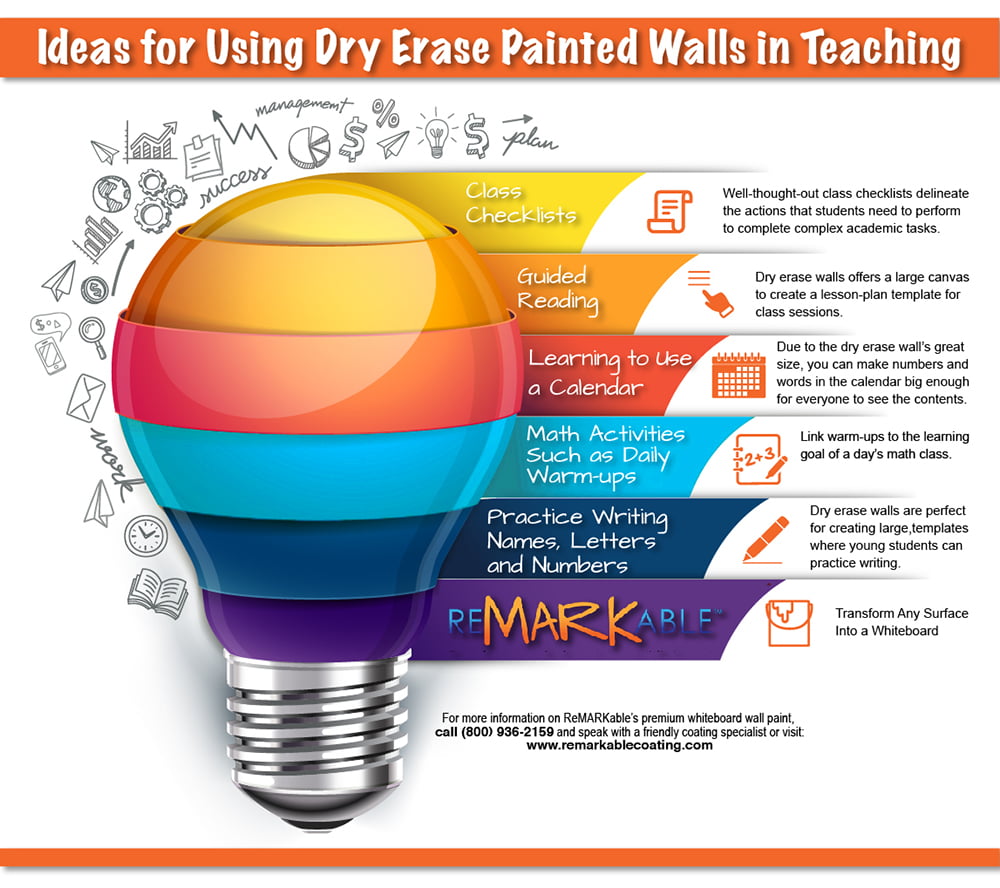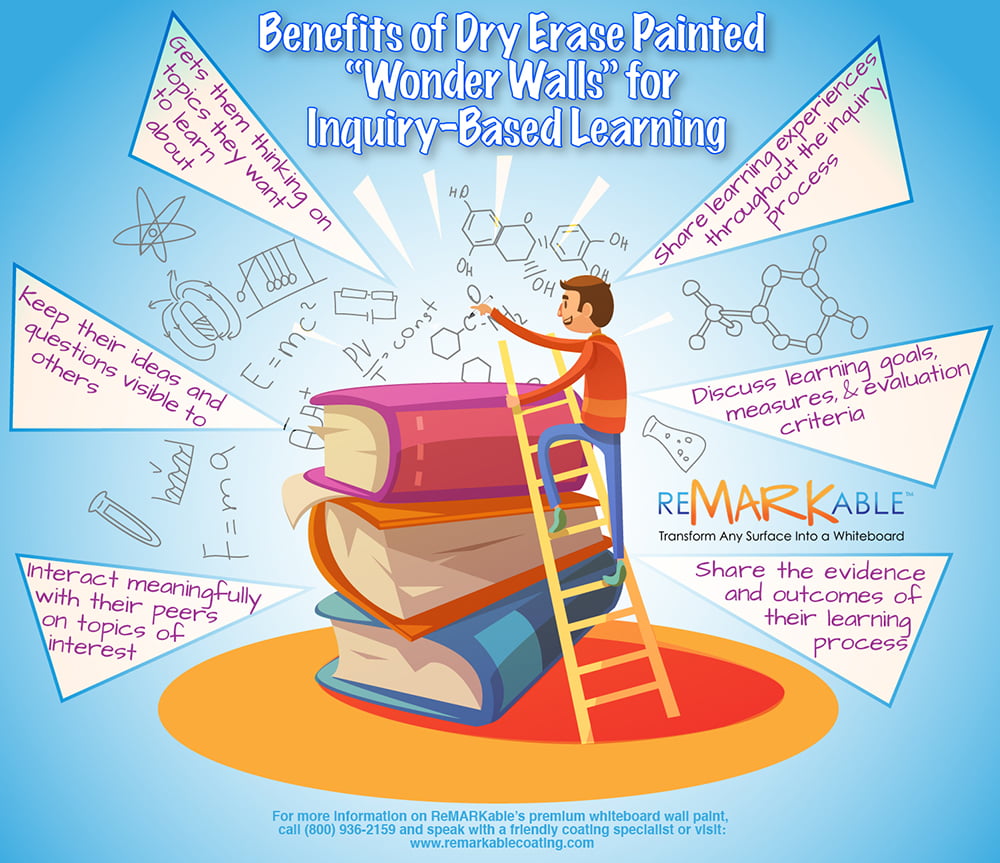
Ideas for Using Dry Erase Painted Walls in Teaching
The classroom is a natural place to use top-quality dry erase painted walls, which offer teachers large, convenient, and attractive surfaces to carry out an endless variety of teaching functions and class activities. The possibilities for using dry erase walls from kindergarten to the university level are limited only by a teacher’s time, energy, and imagination. From small-group work like solving math problems to whole-class activities such as brainstorming essay topics, dry erase walls are unsurpassed in terms of size, functionality, and ease of use.
These days, intense student engagement is the name of the game in education at all levels. It’s a significant quality that supervisors hope to see when they observe your classes. And a great way to get your students more engaged in learning is by using dry erase walls in the classroom.
The following are some creative ideas for making use of dry erase walls with classes of various grade levels and in diverse subject areas. These activities can not only get students more excited about their classwork but also make learning more fun for pupils and teachers alike.
For Practice in Writing Names, Letters, and Numbers
Dry erase walls are perfect for creating large, convenient templates where young students can practice writing their names, the numbers, and the alphabet. To make a template for writing practice, you can use a yardstick and automotive pinstriping tape or another type of tape to create several evenly spaced rows of horizontal lines on your dry erase wall. On these lines, students can repeat the writing of numbers, letters, and their names until they’ve mastered correct execution and form.
The wall’s vast size will allow you to make large spaces between the lines so that students can write in big letters and numbers. Doing so will be fun and may help in remembering the content better than writing small text on paper or a framed whiteboard. The children should practice printing in the traditional manuscript style for each letter and number.
Give Thorough Instructions and Representations to Trace Over
When they use the template, it’s essential to give students detailed instructions on how to write the letters and numbers. Before a practice session, you should also create at least one large dashed representation of each letter and number on the template, along with numbered arrows to show the steps involved in correct formation. The dashed versions are meant for the students to trace over to help them get acquainted with proper form. You can also draw circles at appropriate spots in the lines on the wall to act as prompts showing where to begin writing each letter or number.
For Learning to Use a Calendar
For teachers who currently have only standard-sized whiteboards or bulletin boards to teach about the structure, contents, and use of calendars, premium dry erase walls can open up a whole new world of instructional options. One popular approach is to use painter’s tape, auto pinstriping tape, or another type of tape to create a large calendar template on your dry erase wall. Due to the wall’s great size, you can make the numbers and words in the calendar big enough so everyone in your class can see the contents from their seats, even from the back of the classroom.
Use Your Calendar Template All During the School Year
After the template is complete, the students can write in the name of the current month, the days of the week, and the correct placement of the dates for the month. The kids can also post national holidays, school sporting events, and other happenings that they might want to include in the appropriate date squares. Then when the month ends, the old information can be erased and the process repeated until the end of the school year. Color coding with different colored markers can be used to distinguish various events such as the first and last days of school and parent-teacher conference days.
For Use in Guided Reading
Guided reading is practiced with a small group of four to six students. The fiction or informational text to be read by the group is selected based on the students’ instructional reading level. The students read the book on their own as the teacher supports them and guides them toward successful comprehension and critical thinking about the contents and structure of the text.
A dry erase wall can come in handy when doing a guided reading lesson, as it offers a large canvas to create a lesson-plan template for a session that may include items like the following:
· Book information: Book title and reading level
· Learning goal of the reading: SWBAT (Students will be able to …)
· Book introduction: Today, we will be reading a new story entitled ____. In this story, ____.
For Use in Math Activities Such as Daily Warm-ups
It’s important to do warm-ups at the beginning of every math class. Linking warm-ups to the learning goal of a day’s math class is an ideal way to spend time while you’re lesson planning. This is so because warm-ups get students engaged from the start of a lesson and also reinforce the prior knowledge they’ve gained for use in learning new material. You can use your dry erase wall as a convenient surface for creating math warm-ups; its size will give you a wide range of options that make the wall preferable to traditional whiteboards.
Using your dry erase wall for math warm-ups is also a helpful way to assess how students are doing. Say, for example, the class is working on place value, a topic that crosses all grade levels. On the wall, you can do several quick problems one by one and have the class show their responses by holding up their notebooks for you to see and evaluate.
Here are some other ways you can begin a lesson on place value with your dry erase wall.
1. a. Have students come up to the wall in small groups.
b. Dictate several numbers to the students.
c. Have the students work together to write the numbers in expanded form with exponents (for higher grades).
2. a. Write several multi-digit numbers on the wall.
b. Have the class identify the place value of various digits that you point to.
3. Provide the class with clues about a certain number (e. g., I’m a two-digit number that’s greater than 50, and my tens digit is twenty times greater than my ones digit; answer: 63); repeat this process as often as you like.
For Class Checklists
Well-thought-out class checklists delineate the actions that students need to perform to complete complex academic tasks. This approach supports students’ meta-cognitive development and cultivates the self-assurance and independence they need to perform these actions in future classwork. By presenting the steps required to learn a process or complete an assignment, checklists can help students develop greater awareness of their own mental processes, which in turn helps them learn more effectively.
Research shows that students who know how they go about learning, know which strategies are most useful when handling a problem or task, and know how to accurately assess their progress are better learners than those who don’t. Checklists created on your dry erase wall can be invaluable tools in accelerating this process in students’ minds.
An example of a checklist on strategies for reading an informational book might look like this:
Did you remember to do the following?
❑ convert the title into a question to answer as you read the text
❑ make note of the original source and reflect on the book’s average readers
❑ look for data on the author and check her credentials for writing about this topic
❑ examine the text by studying the headings, and visual aids included
❑ review the book by reading the introductory paragraphs and final paragraph
❑ write a note to yourself about the book’s topic and the author’s approach to the topic
Such a well-designed operational checklist is a powerful tool that can help you to teach well enough so that students no longer need your help with what you’ve taught. They can instead become independent learners with the skills to acquire knowledge and skills largely on their own.
The post Ideas for Using Dry Erase Painted Walls in Teaching appeared first on ReMARKable Whiteboard Paint.
source https://www.remarkablecoating.com/ideas-for-using-dry-erase-painted-walls-in-teaching/


